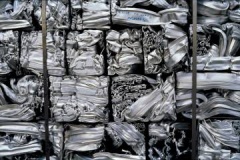Aluminium Waste
| Infobox on Aluminium Waste | |
|---|---|
| Example of Aluminium Waste |  |
| Facts | |
| Origin | - |
| Stowage factor (in m3/t) | - |
| Humidity / moisture | - |
| Ventilation | - |
| Risk factors | Aluminium dross, aluminium residues and aluminium skimming are listed; reference is made to the relevant IMO regulations of hazardous cargo. |
Aluminium Waste
Description
Aluminium recycling is the process by which scrap aluminium can be reused in products after its initial production. The process involves simply re-melting the metal, which is far less expensive and energy intensive than creating new aluminium through the electrolysis of Aluminium Oxide (Al2O3), which must first be mined from bauxite ore and then refined. Recycling scrap aluminium requires only 5% of the energy used to make new aluminium. For this reason, approximately 31% of all aluminium produced in the United States comes from recycled scrap. Used beverage containers are the largest component of processed aluminum scrap, with most UBC scrap manufactured back into aluminum cans.
Sources for recycled aluminium include aircraft, automobiles, bicycles, boats, computers, cookware, gutters, siding, wire, and many other products that need a strong light weight material, or a material with high thermal conductivity. As recycling does not damage the metal's structure, aluminium can be recycled indefinitely and still be used to produce any product for which new aluminium could have been used.
The recycling of aluminium generally produces significant cost savings over the production of new aluminium even when the cost of collection, separation and recycling are taken into account. Over the long term, even larger national savings are made when the reduction in the capital costs associated with landfills, mines and international shipping of raw aluminium are considered.
Distinction must be made between:
- Scrap from used objects such as plates, tubes, tanks, water kettles, etc (harmless)
- Scrap produced during the manufacturing of objects such as borings, cuttings, filings shavings and turnings (dangerous; mainly contaminated with oil)
- Scrap generated through the production of aluminium, as dross, skimming (almost always dangerous).
Aluminium is a very expensive non ferrous metal and can therefore produce high incomes for recycling schemes. Alumium waste is produced primarily from two main streams, the production lines of aluminium industry and the alumium as an end-of-life product, after its use by the consumers. In both cases the option of recycling is favourable and widely implemented in many parts of the developed world.
Application
The scrap aluminium is separated into a range of categories e.g. irony aluminium (engine blocks etc.), clean aluminium (alloy wheels). Depending on the specification of the required ingot casting it will depend on the type of scrap used in the start melt. Generally the scrap is charged to a reverberatory furnace (other methods appear to be either less economical and/ or dangerous) and melted down to form a "bath". The molten metal is tested using spectroscopy on a sample taken from the melt to determine what refinements are needed to produce the final casts. After the refinements have been added the melt may be tested several times to be able to fine tune the batch to the specific standard.
Once the correct "recipe" of metal is available the furnace is tapped and poured into ingot moulds, usually via a casting machine. The melt is then left to cool, stacked and sold on as cast silicon aluminium ingot to various industries for re-use.
Shipment / storage
Depending on the packing group, dangerous wastes must be shipped in hermetically sealed, reliable metal drums. Aluminium cuttings, with 2% moisture content, have been permitted to be packed in plywood cases on pallets. Aluminium skimming, dry and packed in sealed plastic bags in GP-containers.
Risk factors
Aluminium dross, aluminium residues and aluminium skimming are listed; reference is made to the relevant IMO regulations of hazardous cargo.











